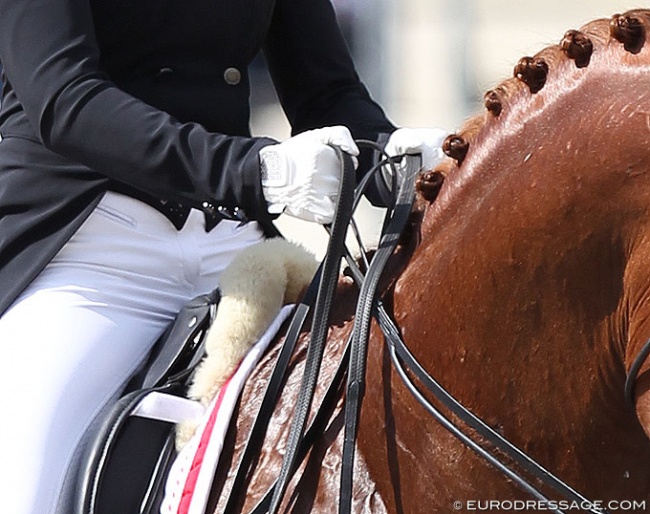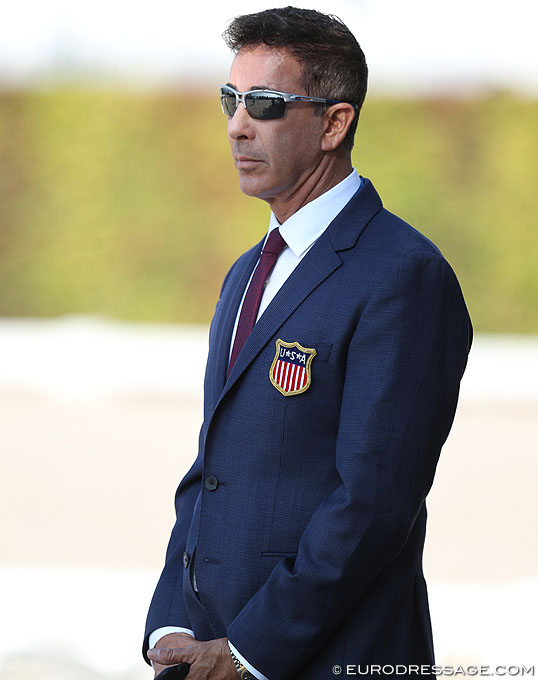
After reading the recent article on rein weight and elasticity, former U.S. team trainer Robert Dover commented that he honestly found the article not so helpful for aspiring trainers, other than Dr. Hilary Clayton saying that “the amount of weight in the rein varies between horse-rider combinations.”
Dover took to Facebook and wrote, “Horses vary greatly in their contact depending on their conformation, mechanics, sensitivity, and reaction to the rider’s aids and abilities. While some horses are naturally heavy in one or both sides on the reins, others dislike contact and are too light. Therefore, the job of the trainer may be to make one horse extremely light and go with one or both reins in a loop while the next horse may need to learn to actually pull quite strongly on one or both reins. Moreover, in both of these circumstances, the trainer may need to change the degree of contact multiple times over the course of the training of the same horse."
Dover continued on what the best rule to teach riders and trainers about contact is.
“The contact in the reins should be as strong or as light as desired by the rider or trainer in any given moment. At all times, the trainer should be able to feel the hocks in their hands to the degree they wish to. What is not acceptable is for the horse to dictate the degree of strength or lightness in the reins. Think of connection like an electrical circuit with the brain of the horse being a lightbulb. The light will always be glowing brightly when the elastic connection from back to front is correct and the horse is thinking beautifully forward and nicely on the aids.” -
I agree with what Robert was saying, but I believe the point was actually that we should aim to have this amount of rein tension. It was more about what we should strive for than what we find in each individual case.
If a horse puts too much weight in the reins, does the rider adapt and learn to ride with a lot of rein tension or do we try with the right exercises to encourage the horse to carry himself with less tension in the rein? And vice versa if he is too light. If one rein has more weight do we work towards finding an even contact on both reins?
Christian Carde says that as a rule riders should aim to establish an even contact on both reins.
“Yes, because most of the time the rein number 2 has an important job to do to compensate or regulate or increase the work of the rein number 1,” Christian explained. “If a horse is too heavy or too light in the rein then the rider must strive to get an equal, elastic, soft contact on both reins. From that he can succeed to have a relaxed, supple horse.”
To further elaborate on these questions I returned to Hilary Clayton to get her more technical response.
Hilary says that the differences in opinions between trainers and scientists simply reflects their different base of knowledge. Trainers are experts in training, but are often not aware of the underlying science.
“Robert echoes the words of the dressage text books that guide correct training. My experience has been that science can provide a new level of understanding of contact in terms of how the reins reflect the horse’s inherent sidedness pattern, the degree of self carriage, and the presence of injuries,” Hilary stated. “When we measure rein tension using force sensors, the technology is well-established and known to be reliable. The values that are measured are real. It has been my interpretation that the rider and horse come to an agreement as to what the baseline tension will be for that combination at that point in the training program. In this, I agree with Robert’s second paragraph (tThe contact in the reins should be as strong or as light as desired by the rider or trainer in any given moment"). What trainers don’t realize until they see the data as well as feeling it is that the tension changes within every stride due to the mechanics of the horse’s movements."
Hilary added that even in the trot there are small oscillations of the head and neck that increase rein tension when the horse is ridden on a contact.

So how does rein sensor technology help?
“Rein sensors measure the amount or quantity of the contact and, as I said above, the measurements are non-negotiable. They indicate the amount of tension in the reins,” Hilary affirmed.
What the sensors don’t tell us however is the quality of the contact and this is something riders learn to feel as Robert is suggesting.
“What I mean by that is you could have a horse that is supple and responsive to a very light rein aid versus a horse that is resistant to the rider’s light rein aids requesting that the horse flex laterally at the poll. These two horses could have the same amount of contact but they would feel very different in our hand. Even if the amount of tension is the same, the first horse feels soft and pleasant, the second feels like a block of wood at the end of the reins,” Hilary added.
And again agreeing with Robert, Hilary says that there are often differences between the left and right reins – some horses more than others.
“These are usually a consequence of the sidedness pattern that the horse is born with. It originates in the horse’s brain and is responsible for asymmetries in pushing power of the left and right hind limbs and differences in the contributions of the left and right forelimbs to the elevation of the forehand. The asymmetries we perceive in rein contact actually originate elsewhere in the horse’s body rather than the jaw and this is why the trainer must work on the entire body of the horse in order to achieve an even contact in both reins. It confirms the importance of a back to front approach to training rather than trying to ‘fix’ the contact in isolation. (Of course they can also be other things like injuries that affect the contact but I’m trying to focus on things related to training.)”adds Hilary.
While she acknowledges that technology can be daunting to the established long time trainers, Hilary affirms that the younger generation is much more willing and eager to embrace the science and incorporate a new perspective into their knowledge base.
“Our job is just to do our best to deliver the facts to those who are open to learning more about the science underlying equine performance,” Hilary concluded.
Related Links
Classical Training: How Much Weight Should We Have in the Reins?
Rein Tension with Bitless Bridles Compared to Single-Jointed Snaffle Bits
The Effect of Martingale Attachments on Rein Tension in the Ridden Horse